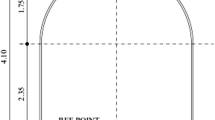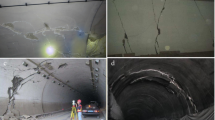Abstract
Severe cases of damages of mountain tunnels following 1995 Hyogoken-Nanbu (Japan), 1999 Chi-Chi (Taiwan), 2004 Mid-Niigata Prefecture (Japan) and 2008 Wenchuan (China) earthquakes have challenged the traditional belief of tunnel structures being seldom damaged in seismic events. These experiences are a reminder that seismic behaviour of mountain tunnels must be further studied in detail. Such investigations assume greater significance as more number of tunnels are being planned to be constructed to meet the infrastructural needs of mountainous regions all around the world. In this paper, seismic damages of mountain tunnels have been reviewed. Prominent failure patterns have been identified based on the case histories of damages. Damages in the form of cracking of tunnel lining, portal cracking, landslide induced failures, uplift of bottom pavement, failures of sidewalls, shearing failure of tunnel liner and spalling of concrete have been majorly observed. Based on the damage patterns and earthquake data, main factors leading to instabilities have been discussed. Probable failure mechanisms of mountain tunnels under seismic loading conditions have been explained. Seismic analyses of a circular lined tunnel in blocky rock mass have been carried out through discrete element based approach. The significant role of different seismic parameters like frequency, peak ground acceleration has been identified. Moreover, effect of tunnel depth on the seismic response of tunnels has been investigated. It is believed that the present study will help in advancing the present state of understanding with regard to the behavior of tunnels under seismic conditions.
































Similar content being viewed by others
References
Asakura T, Sato Y (1996) Damage to mountain tunnels in hazard area. Soils Foundations, Special Issue, pp 301–310
Asakura T, Sato Y (1998) Mountain tunnels in the 1995 Hyogoken-Nanbu earthquake. Q Rep RTRI 39(1):9–16
Brown IR, Brekke TL, Korbin GE (1981) Behavior of the Bay Area Rapid Transit tunnels through the Hayward fault. US Department of Transportation, Urban Mass Transportation Administration. Report UMTA-CA-06-0120-81-1, Washington, DC
Cai JG, Zhao J (2000) Effects of multiple parallel fractures on apparent attenuation of stress waves in rock masses. Int J Rock Mech Min Sci 37(4):661–682
Campbell KW (1981) Near source attenuation of peak horizontal acceleration. Bull Seismol Soc Am 71:2039–2070
Chen Z, Shi Z, Li T, Yuan Y (2012) Damage characteristics and influence factors of mountain tunnels under strong earthquakes. Nat Hazards 61:387–401. doi:10.1007/s11069-011-9924-3
Dowding CH, Rozen A (1978) Damage to rock tunnel from earthquake shaking. J Geotech Eng Div ASCE 104(GT2):175–191
Duke CM, Leeds DJ (1959) Effects of earthquakes on tunnels. In: RAND Protective Construction Symp
Hashash YMA, Hook JJ, Schmidt B, Yao JIC (2001) Seismic design and analysis of underground structures. Tunn Undergr Space Technol 16:247–293. doi:10.1016/S0886-7798(01)00051-7
Huang RQ, Li WL (2009) Analysis of the geo-hazards triggered by the 12 May 2008 Wenchuan earthquake, China. Bull Eng Geol Environ 68:363–371. doi:10.1007/s10064-009-0207-0
Itasca Consulting Group Inc. (2004) Universal Distinct Element Code User’s Manual. Minneapolis
Jiang Y, Wang C, Zhao X (2010) Damage assessment of tunnels caused by the 2004 Mid Niigata Prefecture Earthquake using Hayashi’s quantification theory type II. Nat Hazards 53:425–441. doi:10.1007/s11069-009-9441-9
Jiao YY, Fan SC, Zhao J (2005) Numerical investigation of joint effect on shock wave propagation in jointed rock masses. J Test Eval 33(3):197–203
Kawakami H (1984) Evaluation of deformation of tunnel structure due to Izu-oshima-kinkai earthquake of 1978. Earthq Eng Struct Dyn 12:369–383. doi:10.1002/eqe.4290120306
Kitagawa Y, Hiraishi H (2004) Overview of the 1995 Hyogoken-Nanbu earthquake and proposals for earthquake mitigation measures. J Jpn Assoc Earthq Eng 4(3) (Special Issue)
Konagai K (2005) Data archives of seismic fault-induced damage. Soil Dyn Earthq Eng 25:559–570. doi:10.1016/j.soildyn.2004.11.009
Konagai K, Hohansson J, Zafeirakos A, Numada M, Sadr AA (2005) Damage to tunnels in the October 23, 2004 Chuetsu earthquake. In: Proceedings of the JSCE Earthquake Engineering Symposium vol 28, p 75. doi:10.11532/proee2005a.28.75
Kontoe S, Zdravkovic L, Potts DM, Menkiti CO (2008) Case study on seismic tunnel response. Can Geotech J 45:1743–1764. doi:10.1139/T08-087
Kramer S (1996) Geotechnical earthquake engineering. Prentice Hall Inc., Upper Saddle River
Kumari SDA, Sitharam TG (2012) Tunnels in weak ground: discrete element simulations. ISRM India J 1(1):17–24
Li T (2012) Damage to mountain tunnels related to the Wenchuan earthquake and some suggestions for Aseismic tunnel construction. Bull Eng Geol Environ 71:297–308. doi:10.1007/s10064-011-0367-6
Lorig LJ, Cundall PA (1989) Modeling of reinforced concrete using the distinct element method. In: Fracture of concrete and rock : SEM-RILEM International Conference, June 17–19, 198, Houston, Texas, USA, pp 276–287
Lunardi P (2008) Design and construction of tunnels: analysis of controlled deformation in rocks and soils (ADECO-RS). Springer, Berlin
Miyabayashi H, Tosaka T, Isogai A, Kojima Y, Yashiro K, Saito J, Asakura T (2008) Basic studies on earthquake damage to shallow mountain tunnels. In: Proceedings of the World Tunnel Congress 2008—Underground Facilities for Better Environment and Safety—India
Murano T, Takewaki N (1984) On earthquake resistance of rock caverns. A report prepared for the NEA Coordinating Group on Geological Disposal OECD/NEA
Myer LR, Pyrak-Nolte LJ, Cook NGW (1990) Effects of single fracture on seismic wave propagation. In: Barton N, Stephansson O (eds) Rock Joints. Balkema, Rotterdam, pp 467–473
O’Rourke TD, Goh SH, Menkiti CO, Mair RJ (2001) Highway tunnel performance during the 1999Duzce earthquake. In: Proceedings of the 15th international conference on soil mechanics and foundation engineering, vol 2. Balkema, Rotterdam, pp 1365–1368
Otsuka H, Mashimo H, Hoshikuma J, Takamiya S, Ikeguti M (1997) Damage to underground structures (1995 Hyogoken Nanbu earthquake). J Res 33:481–509
Owen GN, Scholl RE (1980) Earthquake engineering of large under, ground structures. Rep FHWA/RD-80/195, prepared for FHWA 279p, URS/John A Blume and Ass
Penzien J (2000) Seismically induced racking of tunnel linings. Int J Earthq Eng Struct Dyn 29(5):683–691. doi:10.1002/(SICI)1096-9845(200005)29:5<683::AID-EQE932>3.0.CO;2-1
Power MS, Rosidi D, Kaneshiro JY (1998) Seismic vulnerability of tunnels and underground structures revisited. 1998. In: Proceedings of North American Tunnelling’98. Newport Beach, CA: Balkema, Rotterdam, The Netherlands, pp 243–250
Roy N, Sarkar R (2015) Effect of mechanical properties of discontinuity on the seismic stability of tunnels in jointed rock mass. In: Proceedings of the 50th Indian Geotechnical Conference, Pune
Sharma S, Judd WR (1991) Underground opening damage from earthquakes. Eng Geol 30:263–276
Shen Y, Gao B, Yang X, Shuangjiang T (2014) Seismic damage mechanism and dynamic deformation characteristic analysis of mountain tunnel after Wenchuan earthquake. Eng Geol 180:85–98. doi:10.1016/j.enggeo.2014.07.017
Shimizu M, Suzuki T, Kato S, Kojima Y, Yashiro K, Asakura T (2007a) Historical damages of tunnels in Japan and case studies of damaged railway tunnels in the Mid Niigata Prefecture Earthquakes. Underground Space—the 4th Dimension of Metropolis, p 1937
Shimizu M, Saito T, Suzuki S, Asakura T (2007b) Results of survey regarding damages of railroad tunnels caused by the Mid Niigata Prefecture Earthquake in 2004. Tunn Undergr 38(4):265–273
Tao S, Gao B, Wen Y, Zhou X (2011) Investigation and analysis on the seismic damage of mountain tunnels subjected to Wenchuan earthquake. Appl Mech Mater 99–100:273–281. doi:10.4028/www.scientific.net/AMM.99-100.273
Wang ZZ, Zhang Z (2013) Seismic damage classification and risk assessment of mountain tunnels with a validation for the 2008 Wenchuan earthquake. Soil Dyn Earthq Eng 45:45–55. doi:10.1016/j.soildyn.2012.11.002
Wang WL, Wang TT, Su JJ, Lin CH, Seng CR, Huang TH (2000) The seismic hazards and rehabilitation of tunnels in central Taiwan after Chi-Chi earthquake. Sino Geotech 81:85–96
Wang WL, Wang TT, Su JJ, Lin CH, Seng CR, Huang TH (2001) Assessment of damage in mountain tunnels due to the Taiwan Chi-Chi earthquake. Tunn Undergr Space Technol 16:133–150. doi:10.1016/S0886-7798(01)00047-5
Wang ZZ, Gao B, Jiang YJ, Yuan S (2009) Investigation and assessment on mountain tunnels and geotechnical damage after the Wenchuan earthquake. Sci China Ser E Technol Sci 52(2):546–558. doi:10.1007/s11431-009-0054-z
Xu Q, Fan XM, Huang RQ, Westen CV (2009) Landslide dams triggered by the Wenchuan earthquake, Sichuan Province, south west China. Bull Eng Geol Environ 68:373–386. doi:10.1007/s10064-009-0214-1
Yashiro K, Kojima Y (2007) Historical earthquake damage to tunnel in Japan and case studies of railway tunnels in the 2004 Niigataken-Chuetsu earthquake. Q Rep RTRI 48(3):136–141
Yoshikawa K (1981) Investigation about past earthquake disasters of railway tunnels. Q Rep RTRI (Railway Technical Research Institute) 22(3):103–111
Yoshikawa K, Fukuchi G (1984) Earthquake damage to railway tunnels in Japan. In: Adv. Tunnelling Technol. Subsurf. Use v 4 n 31984, Prot of Underground Struct Against Seism Eff Jt Open Sess ITA/SOCVENOS. Caracas, Venezuela, 6 Jun 1984, pp 75–83
Zhang JX (2013) Earthquake mechanics study with health check for a seismic-damaged tunnel suffered from the Wenchuan earthquake. Appl Mech Mater 387:68–71. doi:10.4028/www.scientific.net/AMM.387.68
Zhao X, Li TB, Tao LJ, Hou S, Li LY, Qiu WG (2013) Failure mechanism of tunnel portal during strong earthquakes. Int Efforts Lifeline Earthq Eng. doi:10.1016/9780784413234.041
Zheng WZ, Bo G, YuanJun J, Song Y (2009) Investigation and assessment on mountain tunnels and geotechnical damage after the Wenchuan earthquake. Sci China Ser E Technol Sci 52(2):546–558. doi:10.1007/s11431-009-0054-z
Zheng S, Jiang S, Wang X (2012) Research on the mechanism of earthquake damage of tunnels. Adv Mater Res 538–541:705–708. doi:10.4028/www.scientific.net/AMR.538-541.705
Acknowledgments
The first author acknowledges the financial support provided by MHRD, Govt. of India. The authors also appreciate the support from the Head of Department, Department of Civil Engineering, MNIT Jaipur for providing necessary support and assistance. The authors would also like to acknowledge the support of the Department of Earthquake Engineering, IIT Roorkee, for granting the permission to utilize the computing facility to carry out the present study.
Author information
Authors and Affiliations
Corresponding author
Rights and permissions
About this article
Cite this article
Roy, N., Sarkar, R. A Review of Seismic Damage of Mountain Tunnels and Probable Failure Mechanisms. Geotech Geol Eng 35, 1–28 (2017). https://doi.org/10.1007/s10706-016-0091-x
Received:
Accepted:
Published:
Issue Date:
DOI: https://doi.org/10.1007/s10706-016-0091-x




